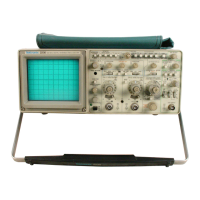--
Options
and
Accessories-2230 Operators
COMMUNICATION AND
WA
VE FORM TRANSFER
This subsection contains information common to both Option 1 O
and
Option
12.
The
commands available, the command
protocol, waveform transfer information,
and
the service request status bytes
are
included
in
this subsection.
READOUT /MESSAGE COMMAND
CHARACTER SET
Character translations performed
by
the MESsage com-
mand
and
query, when sending data to or receiving data
from the
CRT
readout,
are
indicated
in
Table 7 -14.
The
standard ASCII character codes
are
given
in
Table 7-15.
NOTE
Values
in
Table
7-14 that have no CRT equivalent
are translated into spaces when sent to the display.
MESSAGES AND COMMUNICATION
PROTOCOL
The
commands available to the user via either the
Option
10
GPIB
or the Option
12
RS-232-C communica-
tions option
can
set some of the instrument's digital
storage operating modes, query the results of measure-
ments
made,
or query the state of the oscilloscope.
The
commands
are
specified
in
mnemonics that
are
related to
the functions implemented. For example, the command
!Nit initializes instrument settings to states that would
exist if the instrument's power was cycled. To further
facilitate programming, command mnemonics
are
similar to
front-panel control
names.
NOTE
All measurement results returned
by
the options
have the same accuracy as
the
main instrument.
Commands
Commands for this instrument, like those for other
Tektronix instruments, follow the conventions established
in
a Tektronix Codes
and
Formats Standard.
The
com-
mand
words were chosen to
be
as
understandable
as
pos-
sible,
while still allowing a user familiar with the commands
to reduce
the
number of key strokes
needed
and
still
have
the command unambiguous. Syntax
is
also standardized
to make the commands easier to learn.
In
the Command tables found at the
end
of this section,
headers
and
arguments
are
listed
in
a combination of
upper-case
and
lower-case characters.
The
instrument
accepts abbreviated headers
and
arguments that contain
at least the upper-case characters shown
in
the tables
(whether sent
in
upper case or lower
case).
The
lower-
case characters may
be
added to the abbreviated (upper
case) version, but they
can
only
be
those shown
in
lower
case.
For a query, the question mark must immediately fol-
low the header. For example, any of the following formats
are
acceptable to the oscilloscope:
VMO? or
vmo?
VMOd? or vmod?
VMOde? or vmode?
HEADERS-A
command consists of at least a header.
Each
command has a unique header, which
may
be
all
that
is
needed
to invoke a command; for example:
!Nit
OPC
ARGUMENTS-Some commands require the addition
of arguments to their headers to describe exactly what
is
to
be
done. If there
is
more to the command than just the
header (including the question mark if it
is
a query), then
the header must
be
followed
by
at least one space.
In
some cases, the argument
is
a single word; for
example:
REFTo
REF4
PLOtSTArt
In
other cases, the argument itself requires another
argument.
When
a second argument, or "link argument,"
is
required, a colon must separate the two arguments. Two
examples of this
are:
ACQuisition REPetitive: SAM
pie
and
WFMpre XINcr:1.0E-3
7-17

